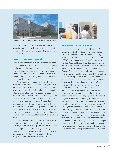
ar2008 19 / 46
10秒後にBOOKのページに移動します
Toagosei Co., Ltd. 17 Toagosei’s Advanced Science Research Laboratory at Tsukuba. Basic Research on Bioinformatics In June 2007, in a joint initiative with a team of researchers at the Department of Molecular Biology, School of Medicine of Keio University, headed by Associate Professor Jun Kudo, we participate in the “GSP (Genome Super Power) Center” (a branch of the Keio Advanced Research Centers) at our Institute for Advanced Sciences in Tsukuba. Joint R&D with the GSP Center is focusing on the Peptide-based Drug Creation Project, aiming at developing peptides with new functions. In the future, we hope that the findings of this research project will fuse with our chemicals technologies and open up new fields of application. This project is also receiving assistance from Professor Emeritus Nobuyoshi Shimizu of Keio University. In 2006, our research project into the role of certain peptides in inducing somatic stem cells to differentiate into neuron cells was chosen by the Japan Science and Technology Agency for its Research Program in Innovative Technology Development. Work is still ongoing in this project, whose goal is to develop cures for intractable nerve diseases such as Parkinson’s disease, retinal degeneration and nerve conditions caused by injury to the spinal cord. The plan is to investigate technologies for differentiating a patient’s own somatic stem cells (skin or bone marrow stem cells) to form nerve cells, which can then be transplanted into the patient to replace damaged nerve tissue. It is hoped that this research, in which we are employing human iPS cells donated by Kyoto University, will make a valuable contribution to progress in regenerative medicine. products for nursing care, other welfare situations, and daily household use. It has also developed plastic molding technologies for new types of synthetic resins such as elastomers. Focus on silicon-based materials Solar cells are at the focus of attention these days for their potential to meet the world’s energy needs while helping protect the natural environment. In line with this social trend, and also to open the way to operations by the Company in a wider range of electronicsrelated fields, we are focusing considerable research efforts on silicon-based materials. We are pinning our hopes for the electronic materials business on TRIES (triethoxysilane) and HCD (hexachlorodisilane), used in making semiconductors, as well as our SQ series of silsesquioxane compounds, which are new silicon-based organic / inorganic hybrid materials. Development is proceeding smoothly on the Q8 series of nano-hybrid silicon-based materials. This development work commenced in February 2007 under an agreement with the US company Mayaterials Inc. Both the SQ and Q8 series are expected to give rise to products with excellent transparency as well as superior heat resistance and scratch resistance. We are looking forward to growing demand for new optical / electronic applications. Going forward, we intend to expand our lineup of special silicon-based materials for the semiconductor industry, and will be investing even more to strengthen our development capabilities in organic / inorganic hybrid materials with high-level special functions. We are planning to develop this lineup of novel silicon compounds into a profitable new business.